Carl Valentine & I Didn't Clean Ale's Fridge
Saturday, June 30, 2007
 My daughter Ale called us this morning at 9. Last night she drove to her new home in Lillooet and arrived at 4 this morning. We spent the afternoon helping her move stuff into her friend Dave's truck and Rosemary, and I cleaned her kitchen, bathroom, etc. During this whole ordeal (and an ordeal it was) I kept thinking of Ale not being near us for the first time in 38 years. Rebecca and Lauren worship her and listen to her gentle admonitions on their behaviour. We will miss her even though Ale was always very Mexican in her relationship with time. It drives Rosemary crazy that to this day Ale will show up at our door step, spur of the moment, without calling. Ale also retains not only her Mexico City accent but also all the slang words of being a chilanga (Mexico City born). On the other hand Hilary, who was also born in Mexico City retains a connection with her father's birth in Argentina. She inherited that illogical attraction to soccer that seems to be in our blood. She has always been crazy about Argentina and its performances in the FIFA World Cup. If she didn't have to work today she would be glued as I will to the Under 20 FIFA World Cup on CBC TV when Argentina plays Czechoslovakia. When Ale called she told us her old place still had some things to pick up and that the fridge had to be cleaned. I went with Rosemary and removed hooks from the wall and emptied the refrigerator. The detritus of someone who has left a house after years of living in it has the power to depress deeply. And this power is double when it affects the ex-tenant's father. I determined then that I was not going to clean the fridge. Rosemary looked at me and said, "I thought your were going to do it." "No, I am going home right now." All the time I had in mind the idea rustling up the only image in my files related to futbol (soccer). It is my photograph of the handsome, and quiet spoken Carl Valentine who came so many years ago to play for the Whitecaps. I had been assigned in the mid 80s to photograph him for Equity. I also had in mind of sitting in front of my TV to watch the Brazilians play Poland. I am sure there are many more fridges for me to clean (and Rosemary will do fine without me this time). The depression is beginning to lift and who knows, perhaps Rebecca will inherit something of her mother and she just might want to sit next to me when I watch Argentina this afternoon.
Lance Henriksen - Very Good At Being Very Bad
Friday, June 29, 2007
In November 1997 Globe & Mail writer Chris Dafoe and I spent some time in actor Lance Henriksen's movie trailer. He was in town filming a TV series called Millenium. When we left, after the end of the interview and the photo session, Dafoe commented to me, "What a likeable guy." I could not disagree as I, too, was astounded by Henriksen's hospitality and gentlemanly demeanor. The November piece in the Globe by Dafoe had the charming title you see above for this blog. And it was accompanied by a photo of mine where Henriksen smiled.

Thinking back on that day and from my perspective of 2007 I realize it all started sometime in 1985 when Vancouver Magazine associate editor Don Stanley told me to photograph a science fiction writer called William Gibson.
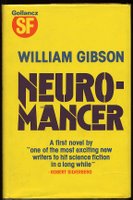
It seems that his 1984 novel Neuromancer had won a science fiction hat trick. It had won the Hugo, the Nebula and the Philip K Dick awards for best novel of that year. I immediately looked for some high technology looking place to photograph the author. I picked Gibson at his Kitsilano home. Getting into my Fiat X-19 presented a problem.My tiny two seater sports car was not able to accomodate his 6ft 5in frame. Gibson ended up with his knees bent to his chin. I took the photo you see here at a new nightclub called Systems that was at the foot of Richards Street. At the time I believed that when one lacked a good photographic idea one resorted (and I did here) to the Dutch Tilt.

Gibson liked his photograph and for many years I was his official photographer. I received calls from Stern, Vanity Fair, Rolling Stone, etc for pictures. But his influence over me (it certainly helped my finances) went beyond. It was from Gibson that I learned to appreciate Raymond Chandler. I remember fondly going to see Terry Gilliam's Brazil with Gibson and John Lekich at the Park on Cambie Street. We discussed the film over coffee across the street.
But it was also Gibson who first told me of American director Kathryn Bigelow and her 1987 vampire western, Near Dark. It was in this scary but wonderful film that I discovered Lance Henriksen.

While this favourite film of mine is one I have only seen once, I do believe I will see it again soon. I will enjoy Henriksen being very good at being very bad.
Death & The Maiden
Thursday, June 28, 2007
The Maiden:
Pass by! Oh, pass by!
Go away, fierce man of bone!
I am still young, go my dear!
And do not touch me.
Death:
Give me your hand, you beautiful and delicate form!
I am a friend, and am not come to punish.
Be of good cheer! I am not savage,
You will sleep softly in my arms!
Death and the Maiden - Franz Schubert
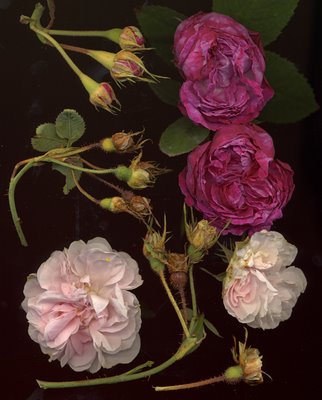
I don't dare buy Reginald Hill's latest The Death of Dalziel (with a far more interesting title in the UK of Death Comes for the Fat Man - Death of Dalziel). I have read all of Hill's Dalziel (pronounced deal) and Pascoe novels and all of his stand alone novels, too (over 25 in all). But I just don't have the nerve to read this one yet to find out as I did with Colin Dexter's The Remorseful Day of the death of the novel's protagonist, Inspector Morse at the end of it.
Only today I made the connection between my sickly Rosa 'Maiden's Blush' and Franz Schubert's String Quartet No 14 (Death and the Maiden) or Schubert's 1817 lied song Der Tod und das Mädchen from which the second movement of that string quartet is based on. When I hear the quartet or the song I brood but I feel nicely depressed. I feel the same when I listen to Miles Davis playing All Blues with that obsessive Paul Chambers bass vamp.
Eight or so years ago I had the last of my terrible weekly migraines. With age I might have outgrown them. I noticed in those last years that I had few migraines in June and July. I quickly found the reason. In June and July I deadhead my roses and fuss over them and smell them. This is so relaxing that whatever stress I had in my system was dissipated by the roses.
One of my favourite Dalziel & Pascoe police procedurals set in Mid Yorkshire is called Deadheads. In this 1983 novel the scene opens with an old woman deadheading roses. She is suddenly aspproached by a young boy. He shows some curiousity so she explains to the young boy, her niece's bastard son, what she is doing:
'Why do you do it?' demanded Patrick.
'Because,'she lectured, 'once the the flowers have bloomed and begun to die, they inhibit - that is to say , they stop - other young flowers from developing and blooming. Also the petals fall and make the bush and the flower-beds look very untidy. So we cut off the blooms. It's called deadheading.'
By the end of that chapter Patrick is being instructed by his great aunt on the art of deadheading. He has posession of the extremely sharp knife.
'Patrick,'she said taking a step back. 'Patrick!'
There was a sting on her bare forearm as the thorns of the richly scented bush dug into her flesh. And then further up, along the upper arm and in the armpit, there was a series of sharper, more violent stings which had nothing to do with the barbs of mere roses.
Mrs Aldermann shrieked once, sent a skinny parchment-skinned hand to her shrunken breast and fell backwards into the rose-bed. Petals showered down on her from the shaken bushes.
Patrick watched, expressionless, till all was still.
Then he let the knife fall beside the old woman and set off running up to the house, shouting for his mother.
This delightful book features chapter titles that are the names of real roses with short descriptions which somehow reveal the action of the chapter. Since Patrick's mother is called Penelope one of the chapters is appropriately called Penelope, a hybrid musk rose. But the ones that made me laugh are Dandy Dick (the first chapter): Floribunda. Clear pink, erect carriage, almost a Hybrid Tea. And the last chapter, when all the loose ends are resolved, is called Félicité Et Perpétue.
All the above has a connecting purpose. I have two favourite roses, Rosa 'Maiden's Blush (also called Cuisse de Nymphe Emu, Incarnata, La Virginale, La Séduisante) and Rosa 'Reine des Violettes'. Both have a fungus disease called Botrytis cinerea. After struggling for five years to check the disease I have come to the conclusion that these two roses in our wet spring weather are pre-disposed to Botrytis and I must uproot them and throw them away. Even today (check the picture above) amongst all the yellowing and aborted buds, both roses produced a few beautiful and fragrant blooms. I have another Maiden's Blush in a different section of the garden that is fine so I don't feel as terrible a pang about doing in my maiden. I recently purchased a clean Reine des Violettes and she will replace my sick one. I am saddened. If you consider all the other names Maiden's Blush has you have to realize that she does seduce.
But at least when I am deadheading my roses with my secateurs I need not watch my back.
More secateurs
Zemblanity, Moscato & William Boyd
Wednesday, June 27, 2007
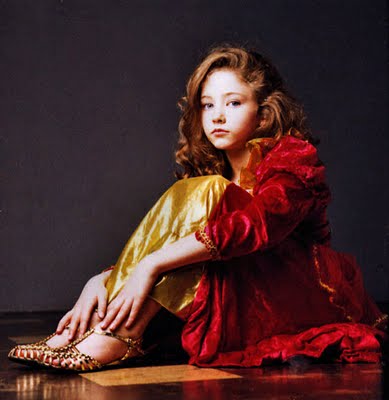
I believe I am beginning to understand that children now are different from children then (my time). While I was thrilled at Gene Kelly's swordfighting skills and mesmerized by the beautiful but evil Lana Turner as Milady in The Three Musketeers Rebecca did not understand what was going on and soon got bored. We switched off the TV. Yet a couple of years back we had enjoyed Gunga Din. I have postponed indefinitely what I think should be a child's passage into early adulthood. This would be the watching of Gary Cooper in Beau Geste. Would I be able to take in stride my disappointment if Rebecca would be bored by it? I saw Beau Geste for the first time at the General Paz in Buenos Aires with my father and mother. I was 8 or 9. Could it be possible that she would not be thrilled by the burning of the toy ship in the Geste garden pond?
Yet three years ago Rebecca, Rosemary and I sat a block away from the General Paz in on Cabildo Street. We were eating on a sidewalk table the marvelous pizza at Burgio. It was a very hot Buenos Aires evening. It was 11:30pm. Rebecca asked me what I was sipping. I was sipping moscato which is a very sweet (it tastes of pure grape juice) wine that is served ice cold. Argentines of back then still indulge in this unlikely combination of sweet wine with pizza. Moscato, 14% alcohol (you would never know) is uncommonly good. Rebecca asked me if she could have some. I passed her the glass and she had a couple of sips which she said she enjoyed. Perhaps my right of passage through Beau Geste with my father and mother somehow has the parallel with Rebecca sipping her moscato at 11pm in a hot Buenos Aires evening.
As a child my grandmother (below, right) often told me of equally hot evenings in turn-of-the-20th century Manila. She told me of the old Spanish quarter called Intramuros (within the walls) and how people dressed and flirted with their Spanish fans.
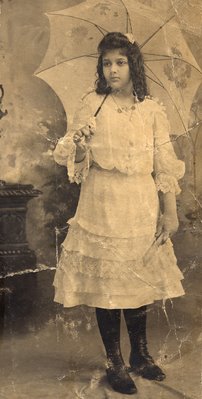
She told me of going to little establishments to sip on ice cold horchata. This is a Spanish non alcholic beverage made from sugar, coconut, rice water and almonds. The beverage was accompanied by ensaimadas which were pastry (very soft and spongy) that was made by twisting the batter (left to rise often) in a nautilus swirl. I enjoy a close approximation of horchata by buying the Italian version called horzata. I buy the syrup in Italian stores. At Goldilocks, on Fur and Broadway, I get the ensaimadas (spelled enzaimadas by the establishment's Filipinos). All I lack to go back to that turn-of-the-century and heavily Spanish influenced Manila is to read one of my favourite books. This is The Blue Afternoon. That the book would be written by a Ghana born Englishman, William Boyd is sort of strange. My Rebecca would not understand that this child (then) would instantly equate William Boyd with Hopalong Cassidy. Luckily I discovered this writer some years ago and I am a reader of his novels. I can tell you that Boyd coined the word zemblanity which is the opposite of serendipity. Boyd defines it as, " The opposite of serendipity, the faculty of making unhappy, unlucky and expected discoveries by design."
The Manila book by Boyd is a time machine into my grandmother's past. I can easily cite it as one of my ten favourite books from my collection. It involves an architect, a surgeon and a some early fliers who may have preceded the Wright Brothers. Reading about Manila at the turn of that century is like listening to my grandmother talk in her Castilian accent. But it is the killer prologue that kills me every time I read it.
Last week on Saturday afternoon I asked Rebecca to turn of the TV and we sat in the living room while I read to her:
The Blue Afternoon
William Boyd
Prologue
I remember that afternoon, not long into our travels, sitting on deck in the mild mid-Atlantic sun on a slightly smirched and foggy day, the sky pale washed-out blue above the smokestacks, when I asked my father what it felt like to pick up a knife and make an incision into living human flesh. He thought seriously for a while before replying.
'It depends on where you cut,'he said.' Sometimes it's like a knife through clay or modelling wax. Some days it's like cutting into a cold blancmange or... or cold raw chicken.'
He pondered pondered a while longer and then reached inside his coat pocket and drew out a scalpel. He removed the small sleeve that protected the blade and offered the slim knife to me.
'Take this. See for yourself.'
I took the scalpel from him, small as a pen but much heavier than I had imagined. He looked down at the remains of our lunch on the table: an edge of cheese with a thick yellow ridn, a bowl of fruit, four apples and a green melon, some bread rolls.'
'Close your eyes, 'he said. 'I'll get something for you, an exact simulacrum.'
I closed my eyes and gripped the scalpel firmly between my thumb and first two fingers. I felt his hand on mine, the gentle pressure on his dry rough fingers, and then he lifted my hand up and I felt him guiding it forward until the poised blade came to rest on a surface, firm, but somehow yielding.
'Make a cut,'he said. 'A small cut. Press down.'
I pressed. Whatever I cut into yielded easily and I moved the blade down an inch or so, or so it seemed, smoothly, with no fuss.
'Keep your eyes closed....What did it feel like?'
I thought for a second or two before replying. I wanted this to be right, to be exact, to be scientific.
'It felt like....Like cold butter, you know, from an icebox. Or a sirloin, like cutting through a tender sirloin.'
'See?'he said. 'There's nothing mysterious, nothing to be alarmed about.'
I opened my eyes and saw his square face, smiling at me, almost in triumph, as if he had been vindicated in some argument. He was holding out his bare left forearm, the sleeve of his coat and shirt pushed back to the crook of his elbow. On a bulge of muscle, six inches above his wrist, a thin two-inch gash oozed bright blisters of blood.
'There, 'he said. 'It's easy. A beautiful incision. Not a waver, with even pressure and with your eyes closed, too.'
The expression on his face changed at this moment, to a form of sadness mingled with pride.
'You know,'he said, 'you would have made a great surgeon.'
----------------------------------------------------------------------------------------------------------------------------
Only later in the book did I find out (with a shock) that the above scene is between a father and daughter.
Alexandra's Spade
Tuesday, June 26, 2007
 The story really began when my daughter Alexandra was born in Mexico City 38 years ago. I will skip all that. Two years ago we suddenly found ourselves the owners of two exquisite hardwood handled stainless steel garden spades. For years I had been using cheap spades ignoring the common sense of not applying too much leverage. I have broken many. I decided then to purchase a good one. So did Ale (Alexandra) who had noticed my track record. I felt saddened that Ale had spent at least $65 on the spade but there was no way I could tell her I already had one. The problem of an extra spade was soon solved when I broke my own. It did not break at the handle. A section of the stainless steel blade simply sheared off. 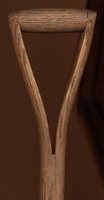 I continued working in the garden with Ale's spade. After using it to pry a large stone to bury our white cat Polilla in the garden I broke the handle off. The solution was simple. I went to 16th Avenue and Dunbar garden repair shop, the one with the nasty old woman who overcharges. Her shop is the last place left in our area that repairs garden equipment. The good handle from one spade was put into Ale's spade. A couple of months ago I broke it. I was determined to end the folly. At Lee Valley Tools I bought a fibre glass handled spade with a lifetime guarantee. I looked at Ale's spade sadly and put it away. Ale is moving to Lillooet this Saturday to live. For the first time in 38 years we will not have her living a few blocks away. Rosemary is upset. So am I but I try to hide it. Ale is moving to a 3/4 acre property. We suspect her house is a shack. She is taking most of her plants. A couple of years ago Ale gave me the rugosa rose, Rosa 'Hansa'. This extremely hardy rose would grow well in Lillooet's Zone 4. But I could not uproot Ale's gift to me. Luckily I found another classic rugosa, Rosa 'Belle Poitveine' at the UBC Botanical Garden shop. Today I took Ale's spade to be repaired at the 16th and Dunbar shop. The old lady has softened up since she came down with Parkinson's. I explained I wanted the spade repaired, no matter the cost. I told her about Ale and Lillooet. She looked at me and with a smile on her face she said, "It will be ready by Friday." I hope that Ale's spade will serve her well and that when Rosa 'Belle Poitevine' blooms next year she will remember that we love her. Ale, I wish you all the best in your new adventure. If you break the spade, don't throw it away. I'll have it fixed.
The Reverend J.H. Pemberton and Erskine McPherson's Buttonhole
Monday, June 25, 2007
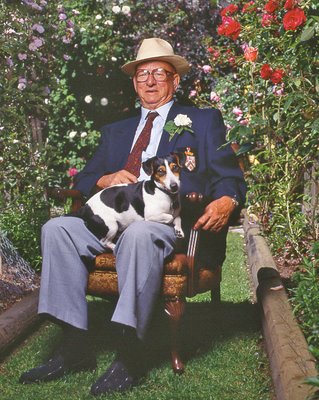 A couple of years ago I walked into McLeod's Books on West Pender and spotted Reverend Joseph H. Pemberton's Roses - Their History, Development And Cultivation. It was a 1908 first edition. Many of the pages had not been cut. This meant that the book had probably never been read. Trying to give my friend and owner of the used book store, Don Stewart my best poker face I asked him for the price. He said, "$50.00 but for you it will be $40.00." I could have sold the book to a collector for $200 that same day but I would never sell this treasure. In the early 20s Pemberton introduced a new class of roses (the first of the modern rose shrubs) that featured smallish flowers but that compensated by being extremely fragrant and which grew in large clusters. Pemberton called them Hybrid Musks. Pemberton's (1852-1926) account on how he first became interested in roses is enough reason to want to keep it. Here it is: My early recollections of church-going are associated with roses. We went every Sunday morning to an old Queen Anne church: ours was a square pew; the pew opener, a woman, walked before us, opened the pew door and shut us in. We sat round facing one another, but could not see anything except the gallery having the royal arms in the centre, the children who sat there with the village schoolmaster, who was also parish clerk and gave out the hymns. When standing-up time came I had to stand on the seat to see over the top of the pew. In a neighbouring pew there was a gentleman who appeared every Sunday with a rose in his buttonhole; I admired that rose and resolved to wear as good if not a better one the next Sunday. During the week I was on the look-out for a suitable one, and when Sunday came again it was gathered – Moss, White-crested Moss, Red Provence at first and then Baron de Maynard or Boule de Neige were favourites. I appeared with my bloom, and when the time came to mount the seat compared it with the rose in the buttonhole of the rival. The result of the judging was usually adverse to me, but I always went home hoping for better luck next time. My flowers were handicapped by the staging; you see I was in petticoats at first and wore a light-coloured Norfolk jacket, large mother-of-pearl buttons down the front and a belt. My rival had a black coat, and the rose had a buttonhole all to itself; there is nothing like black to set off a rose, specially when added to this the flower did not have to share the buttonhole with a large button. I was quite aware of the drawback, and longed for the time when I might have a cloth jacket with a buttonhole on the side.--------------------------------------------------------------------------------------------------------------------------------- Apart from the autobiographical gem from his book, I have been unable to find much information on the Reverend Pemberton, who was born in Essex and lived there most of his life. He died in 1926, one year after he hybridized one of his most popular roses, Rosa 'Cornelia'. Here you see a scan of my specimen. Cornelia's blooms are smallish but they come in giant clusters. Best of all, besides having that odd but attractive moschata (musk) fragrance, she is extremely shade tolerant and disease resistant. I have also been unable to find any image of Pemberton. 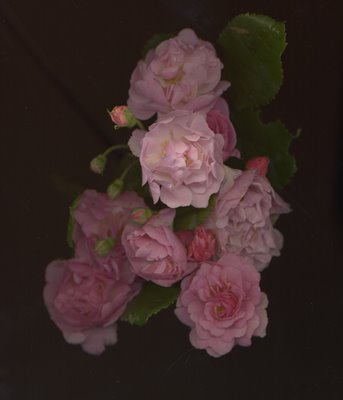 When Rosemary first took me to a Vancouver Rose Society meeting some 15 years ago I suffered on the hard chairs and the interminable projection of bad rose slides. The only light moments of those evenings were provided by a giant and bald old man with a booming voice. Erskine McPherson had the driest and most wonderful humour and could really grow roses. In the picture above, which I took a few years before his recent death you can spot the rose in his lapel and his beloved Jack Terrier, whose name was Jack. With no existing image of the Reverend Joseph Pemberton it is not too hard for me to imagine that the Reverend Pemberton and Erskine McPherson perhaps looked the same. Another of my Pemberton favourites is Rosa 'Penelope' and Rosa 'Bishop of Darlington'. Of the latter I wish I could find out who the man was and why Pemberton would dedicate and name a rose after him.
A Shropshire Lad
Sunday, June 24, 2007
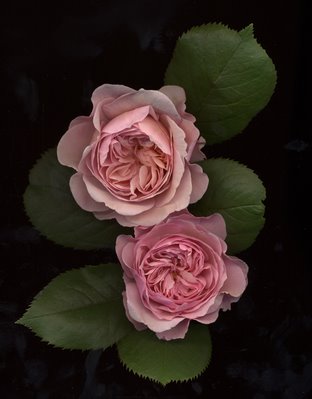 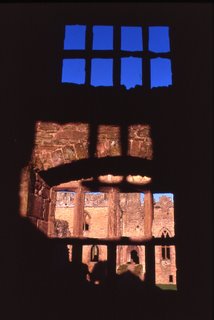 English rosarian and hybridizer David Austin has named a few of his English Roses after locations and people who lived in Shropshire. There is a red rose called Wenlock and my beautiful pink rose seen here, Rosa 'A Shropshire Lad'. I also have the pale yellow Mary Webb and a rose that perhaps A. E. Housman would have ignored, Rosa 'A Shropshire Lass'. I took the photographs below at Stokesay Castle and at Ludlow Castle. For some unknown reason Rosa 'Brother Cadfael' has been shy in blooming this year. When I was one-and-twenty I heard a wise man say, `Give crowns and pounds and guineas But not your heart away; Give pearls away and rubies But keep your fancy free.' But I was one-and-twenty No use to talk to me.  When I was one-and-twenty I heard him say again, `The heart out of the bosom Was never given in vain; 'Tis paid with sighs a plenty And sold for endless rue.' And I am two-and-twenty And oh, 'tis true, 'tis true. XXIII A Shropshire Lad A.E. Houseman   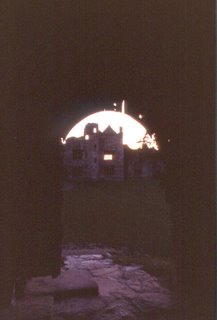
|

























